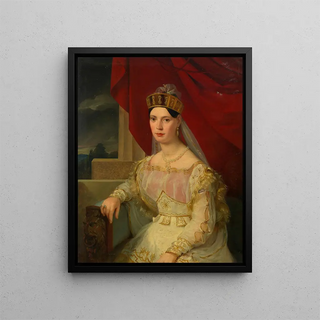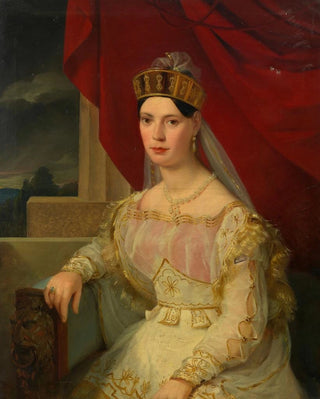Art print | Thérèse Eller Tänzerin - Friedrich von Amerling


View from behind

Frame (optional)
In the fascinating world of 19th-century painting, the art print "Thérèse Eller Tänzerin" by Friedrich von Amerling stands out for its ability to capture the very essence of grace and beauty. This painting, depicting a dancer in full motion, evokes not only movement but also the emotion and sensuality emanating from dance. The representation of Thérèse Eller, a renowned dancer of the time, is an ode to the art of ballet, where each brushstroke seems to vibrate to the rhythm of music. The piece invites viewers into a world where elegance and passion meet, offering a visual experience that is both immersive and captivating.
Style and uniqueness of the art print
The style of Friedrich von Amerling is characterized by finesse and precision that testify to his exceptional talent. In "Thérèse Eller Tänzerin," the meticulous details of the dancer's clothing, as well as the delicacy of her movements, reveal remarkable technical mastery. The color palette chosen by the artist, subtle and harmonious, helps create a light and airy atmosphere, almost ethereal. The play of light and shadow accentuates the dynamism of the dancer while highlighting her expressive face. This art print does not merely depict a dancer; it tells a story, that of a woman who lives her passion fully, embodying both strength and fragility. The carefully balanced composition allows the viewer's gaze to wander through the details while appreciating the scene as a whole. Thus, the piece transcends a simple portrait to become a true celebration of feminine beauty.
The artist and his influence
Friedrich von Amerling, born in 1803 in Vienna, was not only a talented painter but also a renowned portraitist. His training at the Vienna Academy of Fine Arts, as well as his travels in Italy, profoundly influenced his style. Amerling was able to absorb the artistic currents of his time while developing a personal approach that was uniquely his own. His work marked his era, making him one of the most sought-after artists in high society.

Matte finish

View from behind

Frame (optional)
In the fascinating world of 19th-century painting, the art print "Thérèse Eller Tänzerin" by Friedrich von Amerling stands out for its ability to capture the very essence of grace and beauty. This painting, depicting a dancer in full motion, evokes not only movement but also the emotion and sensuality emanating from dance. The representation of Thérèse Eller, a renowned dancer of the time, is an ode to the art of ballet, where each brushstroke seems to vibrate to the rhythm of music. The piece invites viewers into a world where elegance and passion meet, offering a visual experience that is both immersive and captivating.
Style and uniqueness of the art print
The style of Friedrich von Amerling is characterized by finesse and precision that testify to his exceptional talent. In "Thérèse Eller Tänzerin," the meticulous details of the dancer's clothing, as well as the delicacy of her movements, reveal remarkable technical mastery. The color palette chosen by the artist, subtle and harmonious, helps create a light and airy atmosphere, almost ethereal. The play of light and shadow accentuates the dynamism of the dancer while highlighting her expressive face. This art print does not merely depict a dancer; it tells a story, that of a woman who lives her passion fully, embodying both strength and fragility. The carefully balanced composition allows the viewer's gaze to wander through the details while appreciating the scene as a whole. Thus, the piece transcends a simple portrait to become a true celebration of feminine beauty.
The artist and his influence
Friedrich von Amerling, born in 1803 in Vienna, was not only a talented painter but also a renowned portraitist. His training at the Vienna Academy of Fine Arts, as well as his travels in Italy, profoundly influenced his style. Amerling was able to absorb the artistic currents of his time while developing a personal approach that was uniquely his own. His work marked his era, making him one of the most sought-after artists in high society.






